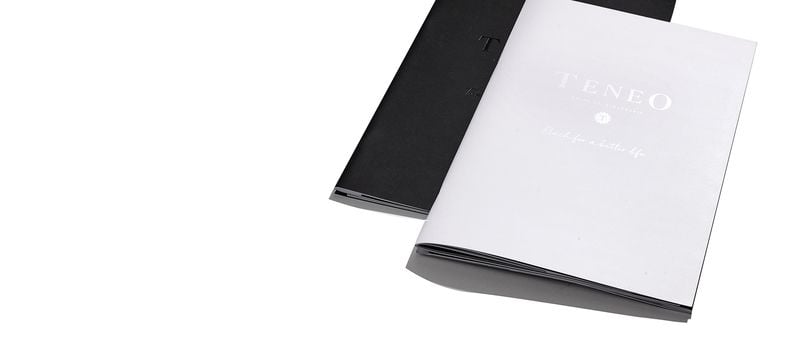The 10 Commandments of Print
)
The 10 commandments of print
Juan Señor, President of global media consultancy Innovation Consulting, gives his ten pressing concerns for print...
1. PRINT DEAD? JUST A FABLE
As new technologies arise, we love to conjure up and highlight fables, including the idea that print is dead. It's not. The notion that one medium kills another is simply not true. If print were a platform, I'd say 'Yes, it's dead. RIP print," because there's no language there, no medium. But print as a medium has permanence. It's eternal.
2. PRINT WILL FIND ITS PLACE
When films arrived many years ago, there was talk that theatre would die. But what we saw was a transition through disruption. We've seen this repeatedly throughout history and for 25 years or more in digital. It also applies to print. We've transported this successful, text-based medium online, and once digital finally finds its own language, print will rediscover its future within that mix.
3. DISPLACEMENT BEATS REPLACEMENT
First comes disruption, then displacement. The web has managed to move into the newspaper space and newspapers have moved into the magazine space. The fact is, you can't keep flogging the same, tired old horse and not reinvent your product.
4. PREMIUM MEANS PRICIER
Within the print space, the 'play' is to make it ever-more premium. Take Versace. It produces very few dresses in the £100,000 price bracket, yet these remain its flagship product. Print has to be reinvented as the premium choice, to have beautiful design, in a larger format, and be a keepsake. And premium must be pricier.
5. FLAT IS THE NEW UP
Everybody's talking about the decline in print circulations. And yes, they will decline. Anybody who pretends they won't is either naïve or nostalgic. But they're not falling off a cliff edge. Eventually, circulations will flatten out at a stable, but still lucrative, level.
6. LESS OFTEN, MORE 'LEAN BACK'
The big, complicated, ever-evolving issue, particularly for newspapers, is frequency. Take FT Weekend. It's a delicious, quality product that's perfect for print. It arrives on a Friday and you spend the entire weekend reading it. You hear about the 'lean-back experience', but if you're going to succeed, you have to provide something that's genuinely 'lean back', like the FT Weekend.
7. BRAND BUILDING? USE PRINT
It's not great for clients to have their brands associated with fake news, so the leading industry voices are singing print's praises. For brand finding, digital trumps print every time. But for brand building, when you're relaunching an entire proposition, print wins.
8. THE DIGITAL FRENZY IS ABSURD
As P&G's Marc Pritchard has said, the misguided flip to digital spending isn't working. This cycle needs to be rebalanced, because it's evident that many millions of pounds aren't performing. And they're not performing because there's this tremendous fraud. You may reach a million people, but you will reach a million people for a quarter of a second, as opposed to 100,000 for 10 or 20 seconds.
9. PRINT UNDERPINS CAMPAIGNS
When it comes to awards, the traditional categories for print and publishing are getting reframed not because advertising interest in those categories is dying. We should be looking at the fact that many campaigns are now integrated and, in many cases, anchored in prestigious print work.
10. TAKE THE FIGHT TO THE DUOPOLY
We've been playing defence for far too long. Google and Facebook have cornered £70bn of ad space globally, but their longevity is not guaranteed. Print has an important role to fill as the situation evolves, and if that means anchoring more campaigns in paper, so be it.
CONTACT US about all your printing needs.
Source: Two Sides
Sustainable Forestry the Facts
)
Sustainable Forestry - THE FACTS
To address the many misconceptions that print and paper are bad for the environment and lead to deforestation, Two Sides have a series of fact sheets available to download for free.
Titled Paper Production and Sustainable Forests, the latest fact sheet explores the issue of sustainable forest management and gathers the most up-to-date information and statistics to debunk many of the myths surrounding forestry to provide irrefutable evidence that responsible forest management can help protect vulnerable forests, as well as create huge areas of new woodland.
"There are 215 million hectares of forest in Europe, which accounts for 33% of the total land area."
It's clear that well-managed forests have a number of benefits for people and society. Forests directly affect the livelihoods of 20% of the global population and also have recreational and cultural importance. They provide products and renewable energy, as well as natural carbon capture and storage. Forests are also home to 80% of terrestrial biodiversity, they control floods and droughts, reduce the risk of erosion and protect our key sources of water.
The stats behind European forestry are staggering: Between 2005 and 2015, European forests grew by 44,160km2 - that's an area larger than Switzerland and equivalent to over 1,500 football pitches of growth every day. There are 215 million hectares of forest in Europe, which accounts for 33% of the total land area. In comparison to other regions in the world, only South America has a higher percentage of forest cover (49%) than Europe.
"European forests have been growing by an area equivalent to 1,500 football pitches every day."
Key to the success of European forestry is certification - the assurance that the wood in a product comes from well-managed and sustainable forests, with an audited chain of custody running from the forest to the customer. The European paper industry supports forest certification with widespread procurement of certified wood fibre and pulp with the use of FSC and PEFC labels, the most prominent forest certification schemes, on products.
As well as the fact sheets, Two Sides have produced the Myths and Facts booklet, a popular resource for companies keen to dispel the myths surrounding the sustainability of print and paper. The publication counters these myths with verifiable facts about the environmental impact of print production and can even be personalised for Two Sides members to provide a valuable tool to share with staff and customers.
Source: Two Sides - written by Sam Upton
Facebook ads replicate print catalogues
)
Facebook Ads Replicate Print Catalogues
The catalogue's reign as a dominant force in marketing is over, but advertisers are still desperate to harness its power. And, Facebook has a new ad format intended to do just that.
The number of catalogues sent every year in the US has halved since 2007, dropping by nearly 10 million, according to the Data & Marketing Association. In 2016, retailers mailed out 9.8 million catalogues, down from the 2007 peak of 19.6 million.
Despite the decline, retailers still spend an estimated $US21 billion to create and distribute print catalogues every year. With almost half of respondents in a Xerox survey reporting that they immediately discard catalogues if they don't think they're relevant, advertisers need to find a way to make that money worth it.
And, Facebook wants to be the platform to do just that.
On Monday, the social network rolled out a new ad format called "lifestyle templates." The format attempts to replicate the look of a print catalogue, with the added bonus that customers can purchase items directly from the Facebook ad.
"There are elements of the catalogue which are really unique and certainly worth replicating," such as their "storytelling potential," Graham Mudd, director of monetisation marketing at Facebook, told Business Insider. "But, I think there are some elements that we're bringing to the experience that are really specific to mobile and to Facebook."
According to Mudd, catalogues typically play a different role in marketing than most mobile and digital ads.
The typical Facebook ad is intended to get someone to click to buy a specific product. Meanwhile, catalogues have traditionally been a source of inspiration - something that customers can look through, get ideas for assembling an entire outfit or redecorating a room, and maybe place some orders later online or over the telephone.
With the lifestyle template, Facebook wants to provide inspiration while also making it more convenient to actually buy the products - something you can't do with a print catalogue.
"It's fairly widely known that circulation and response rates for catalogues have been declining, but it's still a really important channel for them, so they're looking for a way to sort of bring that to the digital world, and specifically the mobile world," Mudd said.
Facebook also has the data to target and personalise the ads based on what it knows about Facebook users.
Source: Business Insider
To dodge ad blockers this bank ran banner ads in newspapers instead
)
To Dodge Ad Blockers, This Bank Ran Banner Ads in Newspapers Instead
Here's an unexpected bright spot for the struggling print industry. One French advertiser is taking its digital banner ads and putting them into a newspaper
Boursorama Bank, a subsidiary of Société Genéralé that specialises in online banking and finance, is running a promotion that offers a 130 credit for an account opened between Nov. 24 and 27. But agency Buzzman has cheekily taken the web-browser version of the coupon and inserted it into a print layout for a newspapersupposedly to reach users who are running ad blocking software.
"We didn't want you to miss our banner ad," reads the copy. "So we put it here."
A small browser window appears below, including a visual button instructing readers to "Click here" to redeem the offera premise that can't but evoke some hapless soul mashing a finger against the page repeatedly, like a toddler trying to swipe left on a magazine cover while mistaking it for a tablet, or Ben Stiller and Owen Wilson jumping on a desk and banging on an iMac like monkeys while trying to get the files out from "in the computer," in that scene from Zoolander.
Naturally, the ridiculousness of the exercise is its real point (rather than circumventing anti-advertising software, as it purports to do). It's certainly chuckle-worthy, though one has to wonder who the campaign's target audience actually is.
Buzzman says the ad will run in France's largest newspapers, so presumably it might be after people old enough to bother reading current events on dead tree. More likely, the brand and agency (Buzzman excels at absurdity) are going for amused online coverage and social chatter and it's earned as much as its getting here, at least.
Sadly, it probably won't be enough to save newspapers in the long run.
CREDITS
Client: Boursorama Banque
Managing Director: Benoît Grisoni
Deputy Managing Director: Aurore Gaspar
Marketing & Portal Director: Xavier Prin
Marketing & Digital Communication Director: Stéphanie Demmerlé
Brand Manager: Tounsia Amrani
Brand Communications Officer: May Khalil
Brand Communications Officer: Alice Mazeyrat
Agency: Buzzman
President and Executive Creative Director: Georges Mohammed-Chérif
Vice President: Thomas Granger
Managing Director: Julien Levilain
Artistic Director / Copywriter: Mickael Krikorian
Artistic Director / Copywriter: Victor Sidoroff
Assistant Artistic Director: Gianni Leotta
Assitant Copywriter: Romuald Mevaere
Head of Account: Bénédicte Muller
Account Director: Laura Quiles
Account Executive: Lola Pegoraro
Strategic Planner: Clément Scherrer
Head of Social Media: Julien Scaglione
Head of PR & Communication: Amélie Juillet
PR & Communication Assistant: Julie Claeyman
PR & Communication Assistant: Suzanne Langlais
Head of Digital Production: François Phan
Digital Production: Renaud Lacassagne
Print Production: Dee Perryman
Source: ADWEEK

)
